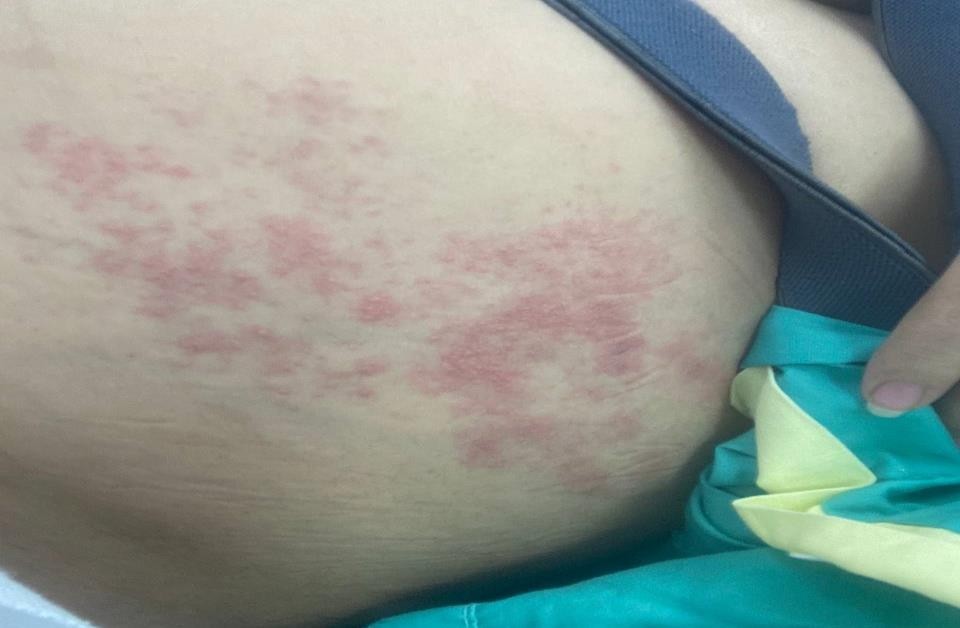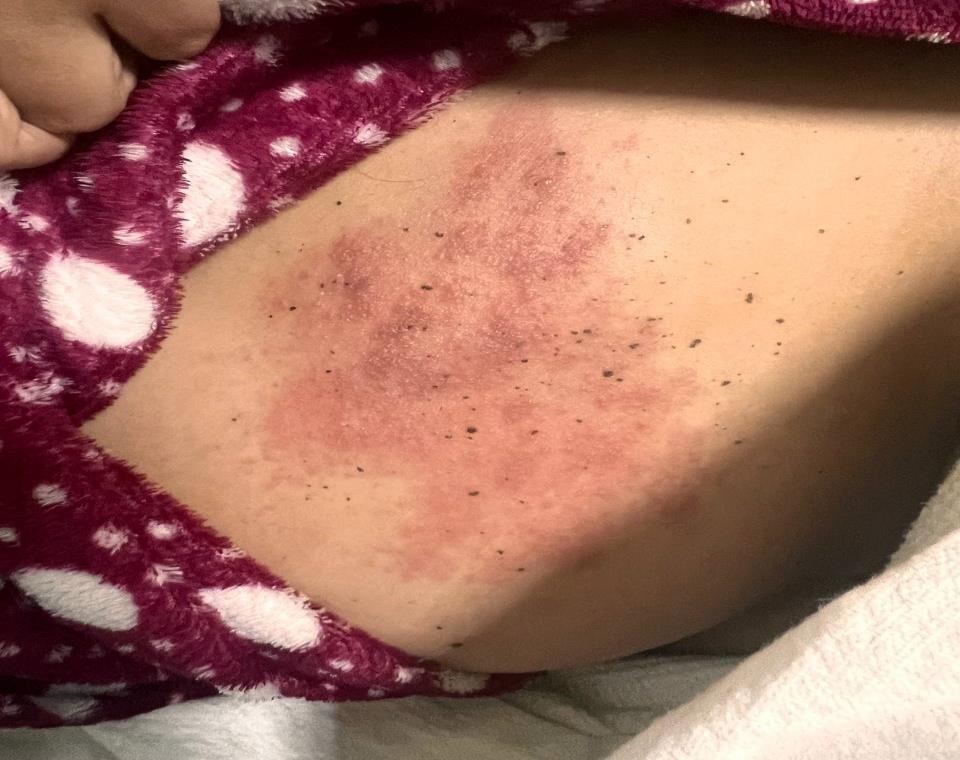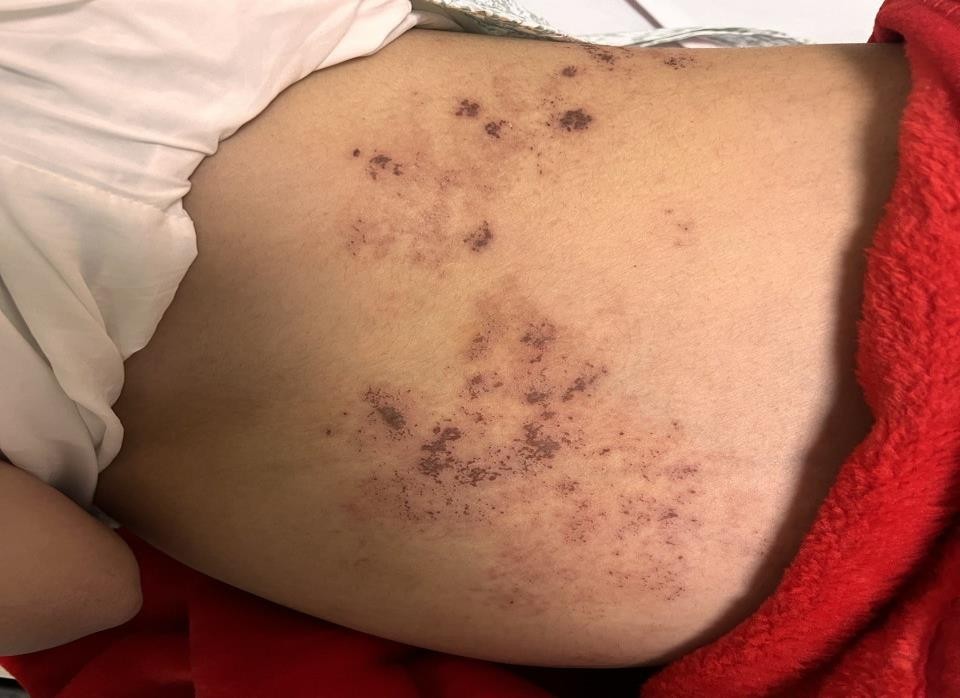A Case Report of Shingles (Herpes Zoster) with Pregnancy
A Case Report of Shingles (Herpes Zoster) with Pregnancy
Roaa Mohamed Ahmed Elhaj *1, Khadeeja Yahya Osman 2, Sara Saror Ahmed Abdallah 3,Al-Sayed A. Abd-Elrahman 4
1.OB/GYN Specialist, Shaqra General Hospital, MBBS (University of Khartoum), Clinical MD in Obstetrics and Gynecology (Sudan Medical Specialization Board), MRCOG, ORCID: 0009-0004-8489-2866.
2.OB/GYN Specialist, King Fahad Hospital, MBBS (University of Medical Science and Technology), Clinical MD in Obstetrics and Gynecology (Sudan Medical Specialization Board), MSC in advanced Ultrasound in Obstetrics and Gynecology, MRCOG ORCID: 0000-0002-5725-9350.
3. Dermatology Specialist, Smile Signature Clinic, MBBS (Islamic University), Clinical MD in Dermatology and Venereology (Sudan Medical Specialization Board).
4. Neonatology Specialist, Shaqra General Hospital, MBBCH (Al- Azhar University), Assistant Professor of Anatomy and Embryology (MD, MCS Anatomy), Port Said University, Egypt.
*Correspondence to: Roaa Mohamed Ahmed Elhaj.
Copyright
© 2024 Roaa Mohamed Ahmed Elhaj. This is an open access article distributed under the Creative Commons Attribution License, which permits unrestricted use, distribution, and reproduction in any medium, provided the original work is properly cited.
Received: 12 August 2024
Published: 21 August 2024
Abstract
Objective: During pregnancy, several infectious illnesses can manifest. The lack of cellular immunity in the mother can affect the development, clinical manifestation, and progression of several conditions throughout pregnancy. Reactivation of the varicella-zoster virus, also known as herpes zoster or shingles, is one of the rarest illnesses that can affect pregnant women. However, neither the mother nor the child are greatly affected by it. Because of the rare appearance of this infection, we present this case.
Case report: A 31-year-old female G6 P4+ 1 was who presented with severe left-sided abdominal pain and a papular rash. She was diagnosed with shingles at 36 weeks of gestation. Her condition improved after receiving supportive care and an antiviral medication (Acyclovir). She had a successful vaginal delivery two weeks later. A neonatologist examined the infant and found no evidence of infection.
Discussion: After a varicella-zoster primary infection, the virus may reactivate to cause herpes zoster if it stays latent in the dorsal root ganglia. There is usually no transplacental infection and no viremia, with the exception of generalized herpes zoster. The mother possesses neutralizing antibodies against the varicellazoster virus, which is transferred to the fetus through the placenta. Certain maternal IgG class antibodies are present in newborns, and the varicella zoster virus typically no longer spreads viremic. Pregnancy-related herpes zoster carries no appreciable dangers for the mother or child. Immunocompetent expectant mothers should treat herpes zoster symptomatically; systemic or topical antiviral medication is not advised.
Conclusions: In contrast to chickenpox, herpes zoster during pregnancy does not raise the risk of congenital abnormalities above the average for that group. To lessen the chance of spreading the varicella zoster virus to vulnerable pregnant women, those with herpes zoster should cover their lesions
A Case Report of Shingles (Herpes Zoster) with Pregnancy
Introduction
The human herpesvirus 3 (varicella-zoster virus, or VZV) is a common alphaherpesvirus with a double-stranded DNA genome. VZV primarily targets T lymphocytes, epithelial cells, and ganglia; it does not naturally infect animals.(1) Varicella, or chickenpox, is caused by primary infection, which causes VZV to become latent in ganglionic neurons.(1) As people age or become sick, their cellular protection against VZV wanes, allowing the virus to reactivate and cause zoster (shingles)(HZ). (1) Viral VZV is extremely contagious and can be transferred from person to person by direct contact with an infected individual's blisters, saliva, or mucus. Coughing and sneezing can spread the virus through the air as well. (2)
Primary VZV infection is a common pediatric illness that typically results in a moderate infection. (3) In England and Wales, more than 90% of people over the age of 15 have VZV immunoglobulin G (IgG) antibody seropositive status.(3) Fever, malaise, and a pruritic rash that turns into maculopapule crops that become vesicular and crust over before healing are the hallmarks of the initial infection. The incubation period is between one and three weeks, and the illness can spread 48 hours before the rash shows signs of appearing and can do so up until the vesicles crust over. Usually, the vesicles crust over in five days. (3) Pregnancy-related varicella infection can spread to the fetus through the placenta. A fetal varicella infection can result in widespread, fatal illnesses. The fetus is protected by vaccination. (4)
In nerval tissue, the VZV virus goes latent following primary infection. (4) Dorsal root ganglia, cranial nerve ganglia, different autonomic ganglia in the enteric nervous system, and astrocytes have all been found to carry VZV.(4) The majority of cell-mediated immunity regulates VZV latency, and its loss is thought to be the cause of reactivation. (4) VZV replicates inside neuronal cell bodies during reactivation. Virus particles are released from the cell bodies and travel down the nerve to the corresponding dermatome. The virus causes vesiculation and inflammation in the afflicted dermatome. The inflammation of the VZV-affected nerves is what causes the pain brought on by HZ. (5)
HZ develops globally and does not vary in frequency seasonally.(6) The frequency of HZ varies based on age, ranging from 1.2 to 3.4 per 1000 individuals annually in younger adults to 3.9– 11.8 per 1000 individuals annually in older individuals (i.e., >65 years).(6) A comprehensive analysis of research conducted between 2002 and 2018 showed the total incidence to be between 2.9 and 19.5 instances per 1000 people, with a predominance of females.(7) Because certain maternal antibodies are transferred to the developing fetus through the placenta, HZ does not present a risk to the developing fetus.(5)(8)
The zoster rash is the primary clinical indicator of HZ, however, an enzyme-linked immunosorbent test and polymerase chain reaction can also be used to confirm the diagnosis. (8) Subacute herpetic neuralgia and post-herpetic neuralgia are the main side effects of HZ. Disseminated HZ, zoster ophthalmicus, and subsequent bacterial infections are additional problems. (4)(8) There have been reports of gastrointestinal and renal problems. Morbidity and mortality is linked to HZ vasculitis. (4) Early intervention with acyclovir or brivudine is the cornerstone of treatment and control of pain is crucial. (4)
Case Report
A 31-year-old lady G6 P4+ 1 in her 36 weeks of pregnancy, presented to the emergency department with left-sided abdominal pain for three days. The pain was severe, throbbing, and burning in nature, continuously all day. She had no fever, change in her bowel habits or urinary symptoms. She did not mention any history of a similar condition. She is known to have hypothyroidism for which she is receiving thyroxin 50 mg. She is not known to have any allergies. Her first delivery was a cesarean section with 3 successful vaginal birth after cesarean sections (VBACs).
Her vitals were normal PR 84, BP 120/75, temperature 36.8. Abdominal examination showed fundal height of 33 weeks, longitudinal lie fetus, cephalic presentation, and positive fetal heart. No apparent abnormality was noticed in her abdomen.
Investigations were ordered which showed CBC showed Hb 11.5 g/dl, TWBCS 9*10000, and PLT 250*10000. Urine analysis revealed pus cells and ketonuria. According to the investigations, a diagnosis of urinary tract infection was made initially, and IV antibiotics were started along with analgesics and hydration. Two days later, the patient’s condition was not improving despite the treatment was given. In addition, she developed a papular rash on T11-T12 dermatomes. A diagnosis of herpetic rash (Shingles) was made. A treatment informs of acyclovir 800 mg tablets / five times per day, topical acyclovir, analgesics, and calamin lotion were prescribed. The patient’s symptoms improved with time and she was discharged after five days in good condition. She had been followed in the outpatient clinic after one week, she reported less pain and the lesions started to crust.
Two weeks later, she presented in Labour when she had a successful VBAC with a healthy baby girl of average weight. The baby was examined by a neonatologist and no evidence of rash was noticed.
Figure (1): Erythematous papular rash at T11-T12 dermatomes
Figure (2): Three days later, vesicles appeared.
Figure (3): 1 Week after treatment started lesions started to crust
Figure (4): Lesions started to heal.
Discussion
Varicella zoster virus causes two different diseases, chickenpox (varicella) and shingles (herpes zoster). The relationship between these two diseases has been understood for more than 100 years and is based on this observation: varicella zoster virus remains latent in human neurons for decades after varicella infection and sufficient varicella zoster virus – specific cell mediated cell mediated immunity is necessary to maintain latency. (9) About 70–80% of HZ patients report prodromal pain in the dermatome, which is followed by the appearance of skin lesions. Each patient typically experiences pain differently, and common descriptions include "burning," "shooting," "stabbing," or "throbbing." While some patients complain mostly of pruritus, others only experience discomfort when the affected area is touched. The prodrome lasts for two to three days on average. Prodromal pain that is severe and lasts a long time frequently prompts doctors to look into conditions that cause pain in the prodrome area, such as angina, cholecystitis, glaucoma, nephrolithiasis, and spinal nerve compression. (10)
These prodromal signs were present in our patient, which have made it challenging to detect the condition right away as no lesions were apparent at that time. However, the diagnosis was obvious as soon as the rash developed, and the patient started therapy. Since the T10 to L1 dermatomes are the source of the uterine sensory nerves, there is a theoretical risk of intrauterine infection during pregnancy after HZ involving these segments. Nevertheless, there are no recorded reports of this type. The risk of infection via maternal viremia was highlighted by a case of congenital abnormalities compatible with CVS (limb hypoplasia and skin scarring) in a child whose mother had disseminated zoster at 12 weeks of gestation. Herpes zoster infection during pregnancy is not associated with an increased risk of congenital malformations above the general population baseline risk or of CVS. (11)
Up until recently, the standard of care for HZ during pregnancy has involved administering antiviral medications or taking acetaminophen regularly for pain. Despite the paucity of research on the safety of antiviral medications during pregnancy, several studies indicate that the fetus is not significantly affected. Antiviral medications are categorized as category B for expectant moms; acyclovir and valacyclovir are advised. (12) Pregnant women should not receive varicella or zoster vaccines as a preventive measure, and it's crucial to counsel pregnant women who are not immune to steer clear of VZV exposure. Individuals with HZ should cover lesions to reduce the risk of transmitting VZV to susceptible pregnant women (8).
Conclusion
In contrast to chickenpox, herpes zoster during pregnancy does not raise the risk of congenital abnormalities above the average for that group. To lessen the chance of spreading the varicella zoster virus to vulnerable pregnant women, those with herpes zoster should cover their lesions.
References
1.Gershon, A.A., Breuer, J., Cohen, J.I., Cohrs, R.J., Gershon, M.D., Gilden, D., Grose, C., Hambleton, S., Kennedy, P.G.E., Oxman, M.N., Seward, J.F., and Yamanishi, K. (2015) ‘Varicella Zoster Virus Infection’. Nature Reviews. Disease Primers 1, 15016
2.Bardsley, M., Loveridge, P., Bednarska, N.G., Smith, S., Morbey, R.A., Amirthalingam, G., Elson, W.H., Bates, C., de Lusignan, S., Todkill, D., and Elliot, A.J. (2023) ‘The Epidemiology of Chickenpox in England, 2016-2022: An Observational Study Using General Practitioner Consultations’. Viruses 15 (11), 2163
3.Green-top Guideline. (2015). Chickenpox in pregnancy (GTG No.13)
4.Patil, A., Goldust, M., and Wollina, U. (2022) ‘Herpes Zoster: A Review of Clinical Manifestations and Management’. Viruses 14 (2), 192
5.Blumental, S. and Lepage, P. (2019) ‘Management of Varicella in Neonates and Infants’. BMJ Paediatrics Open [online] 3 (1), e000433. available from <https://bmjpaedsopen.bmj.com/lookup/doi/10.1136/bmjpo-2019-000433> [27 April 2024]
6.Nair, P.A. and Patel, B.C. (2024) ‘Herpes Zoster’. in StatPearls [online] Treasure Island (FL): StatPearls Publishing. available from <http://www.ncbi.nlm.nih.gov/books/NBK441824/> [27 April 2024]
7.Van Oorschot, D., Vroling, H., Bunge, E., Diaz-Decaro, J., Curran, D., and Yawn, B. (2021) ‘A Systematic Literature Review of Herpes Zoster Incidence Worldwide’. Human Vaccines & Immunotherapeutics [online] 17 (6), 1714–1732. available from <https://www.tandfonline.com/doi/full/10.1080/21645515.2020.1847582> [27 April 2024]
8.Hayward, K., Cline, A., Stephens, A., and Street, L. (2018) ‘Management of Herpes Zoster (Shingles) during Pregnancy’. Journal of Obstetrics and Gynaecology: The Journal of the Institute of Obstetrics and Gynaecology 38 (7), 887–894
9.Gershon, A.A., Gershon, M.D., Breuer, J., Levin, M.J., Oaklander, A.L., and Griffiths, P.D. (2010) ‘Advances in the Understanding of the Pathogenesis and Epidemiology of Herpes Zoster’. Journal of Clinical Virology: The Official Publication of the Pan American Society for Clinical Virology 48 Suppl 1 (Suppl 1), S2-7
10.Dworkin, R.H., Johnson, R.W., Breuer, J., Gnann, J.W., Levin, M.J., Backonja, M., Betts, R.F., Gershon, A.A., Haanpää, M.L., McKendrick, M.W., Nurmikko, T.J., Oaklander, A.L., Oxman, M.N., Langston, D.P., Petersen, K.L., Rowbotham, M.C., Schmader, K.E., Stacey, B.R., Tyring, S.K., Wijck, A.J.M.V., Wallace, M.S., Wassilew, S.W., and Whitley, R.J. (2007) ‘Recommendations for the Management of Herpes Zoster’. Clinical Infectious Diseases [online] 44 (Supplement_1), S1–S26. available from <http://academic.oup.com/cid/article/44/Supplement_1/S1/334966/Recommendations-for- the-Management-of-Herpes> [6 May 2024]
11.Pupco, A., Bozzo, P., and Koren, G. (2011) ‘Herpes Zoster during Pregnancy’. Canadian Family Physician Medecin De Famille Canadien 57 (10), 1133
12.Kim, J.Y., Ko, Y.R., Sim, S.E., Oh, S., Lee, M.H., and Park, H.J. (2020) ‘Safe Drug Treatment and Procedure for Herpes Zoster in Pregnancy: A Case Report’. Chinese Medical Journal [online] 133 (16), 1999–2000. available from <https://journals.lww.com/10.1097/CM9.0000000000000927> [6 May 2024].

Figure 1

Figure 2

Figure 3

Figure 4
